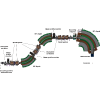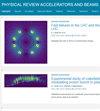Rotatorlike gantry optics
IF 1.8
3区 物理与天体物理
Q3 PHYSICS, NUCLEAR
Physical Review Accelerators and Beams
Pub Date : 2024-07-26
DOI:10.1103/physrevaccelbeams.27.073502
引用次数: 0
Abstract
Rotating gantries are commonly used in ion-therapy facilities to assist and support optimizing the dose distribution delivered to the patient. They are installed at the end of the beamlines and rotated mechanically in the treatment room. In synchrotron-based facilities, the gantries must be able to transport slowly extracted beams with essentially different emittance patterns in the two transverse planes. Such beams will be referred to as the asymmetric beams. A special device called rotator has been proposed as a possible solution. The worldwide first beamline with the rotator has been recently commissioned. The original rotator concept uses an “external” rotator that is a part (a module) of the beamline the gantry is connected to. In this paper, a novel gantry ion-optical concept integrating the rotator optics into the gantry optics is introduced. The first-order gantry transfer matrix satisfies the so-called sigma-matching ion-optical constraints, and—at the same time—it possesses the format of a rotator transfer matrix. The rotator-matching and the sigma-matching principles are combined in the gantry transfer matrix, which means that the sigma-matching gantry acts simultaneously as a rotator without the need for an extra rotator device. In addition, scattering in the gantry nozzle is used to balance the asymmetric beam emittances in the two transverse planes without an additional scattering foil. In this way, the presented ion-optical concept combines all three known matching techniques—the sigma matching, the rotator matching, and the scattering-foil matching—within the gantry beam transport system. Such a beam transport system provides the best matching result and full angular independence of the beam parameters at the gantry isocenter. It also makes it possible to optimize the beam parameters not only at the gantry isocenter but also at the beam monitors located in the gantry nozzle without increasing the number of gantry quadrupoles. There are two possible versions of such gantry optics: the point-to-point and the parallel-to-point optics. They both are presented in this paper. Theoretical calculations are supported by beam transport simulations performed with the winagile code. Feasibility of the newly proposed ion-optical concept is demonstrated on the MedAustron proton gantry. However, it can be applied to any rotating gantry at any ion-therapy facility. The presented design is the first rotatorlike gantry ion-optical concept worldwide.

旋转式龙门光学系统
旋转龙门通常用于离子治疗设施,以协助和支持优化输送给病人的剂量分布。它们安装在光束线的末端,并在治疗室内进行机械旋转。在同步加速器设施中,龙门架必须能够传输在两个横向平面上具有基本不同发射模式的缓慢提取的光束。这种光束将被称为非对称光束。有人提出了一种名为旋转器的特殊装置作为可能的解决方案。全球第一条配备旋转器的光束线已于近期投入使用。最初的旋转器概念使用的是 "外部 "旋转器,它是与龙门连接的光束线的一部分(模块)。本文提出了一种新的龙门离子光学概念,将旋转器光学元件集成到龙门光学元件中。一阶龙门传输矩阵满足所谓的Σ-匹配离子-光学约束条件,同时具有旋转器传输矩阵的格式。龙门传输矩阵结合了旋转器匹配和西格玛匹配原理,这意味着西格玛匹配龙门可同时充当旋转器,而无需额外的旋转器装置。此外,龙门喷嘴中的散射可用于平衡两个横向平面上的不对称光束幅射,而无需额外的散射箔片。通过这种方式,提出的离子光学概念在龙门光束传输系统中结合了所有三种已知的匹配技术--σ匹配、旋转器匹配和散射箔匹配。这种光束传输系统提供了最佳的匹配效果,并使龙门等中心的光束参数完全不受角度影响。它还能在不增加龙门四极杆数量的情况下,不仅优化龙门等中心的光束参数,而且优化龙门喷嘴中光束监测器的光束参数。这种龙门光学系统有两种可能的版本:点对点光学系统和平行对点光学系统。本文将介绍这两种方案。理论计算得到了用 winagile 代码进行的光束传输模拟的支持。在 MedAustron 质子龙门架上演示了新提出的离子光学概念的可行性。不过,它也可以应用于任何离子治疗设备的任何旋转龙门架。所介绍的设计是全球首个旋转式龙门离子光学概念。
本文章由计算机程序翻译,如有差异,请以英文原文为准。
求助全文
约1分钟内获得全文
求助全文
来源期刊

Physical Review Accelerators and Beams
Physics and Astronomy-Surfaces and Interfaces
CiteScore
3.90
自引率
23.50%
发文量
158
审稿时长
23 weeks
期刊介绍:
Physical Review Special Topics - Accelerators and Beams (PRST-AB) is a peer-reviewed, purely electronic journal, distributed without charge to readers and funded by sponsors from national and international laboratories and other partners. The articles are published by the American Physical Society under the terms of the Creative Commons Attribution 3.0 License.
It covers the full range of accelerator science and technology; subsystem and component technologies; beam dynamics; accelerator applications; and design, operation, and improvement of accelerators used in science and industry. This includes accelerators for high-energy and nuclear physics, synchrotron-radiation production, spallation neutron sources, medical therapy, and intense-beam applications.
 求助内容:
求助内容: 应助结果提醒方式:
应助结果提醒方式:


